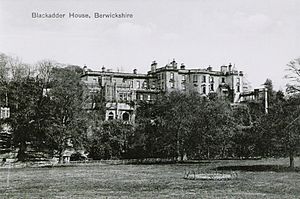Blackadder House facts for kids
Quick facts for kids Blackadder House |
|
|---|---|

Blackadder House
|
|
| Official name: Blackadder House | |
| Lua error in Module:Location_map at line 420: attempt to index field 'wikibase' (a nil value). |
Blackadder House was a grand estate and large house. It was located near the village of Allanton in Berwickshire, Scotland. The house was built where an older building, Blackadder Castle, once stood. Sadly, soldiers damaged the house during World War I. Because there was no money to fix it, Blackadder House was torn down around 1925.
Contents
The Early Story of Blackadder Estate
The Blackadder family was very important in the Scottish Borders area. They often fought with English raiders. King James II gave them more land as a reward. This was for bravely fighting off the English.
Over time, the Blackadder family's lands became part of the Home family. This happened through marriages in 1518. The Home family, now called the Home Robertson family, still owns some of these historic lands.
The Blackadder family lost many members in the Battle of Flodden in 1513. This left two young daughters, Beatrix and Margaret, as the only heirs. The Home family then gained control of the Blackadder lands. The daughters were very young when they were married to younger sons of the Home family. They lived at Blackadder Castle until they grew up.
Later, a cousin, Sir John Blackadder, tried to get the lands back. But this dispute was settled by force. Sir John was executed in 1531. His brother, Patrick, continued the claim. However, Patrick was also killed near Edinburgh.
After these events, the Blackadder family gave up their claim to the Borders lands. In 1671, Sir John Home was given the title Baronet of Blackadder. The Home family owned the estate until 1836. Then, the Houston family, later called Houston-Boswalls, bought it. In 1857, Sir George A.F.H. Boswell was listed as the owner.
Blackadder House: A Grand Home
The original Blackadder Castle was likely a simple peel tower. This type of tower was used for defense. It probably stayed much the same until the mid-1700s.
Later, famous architects like James Playfair and Robert Adam drew plans for the house. Robert Adam's plans were actually built. By 1842, Blackadder House was described as a beautiful, modern building. It had many gardens and greenhouses. It also had a lovely Gothic-style conservatory.
A description from 1845 highlighted the conservatory. It looked like a Gothic chapel. Its frame was made of cast iron. Some of its glass panels were stained. The previous owner, Thomas Boswall, had built it. It cost a lot of money. An 1848 magazine also mentioned the conservatory. It seemed to be the most special part of the house. Lady Houston owned the house at that time.
In 1853, John Lessels made the house even bigger. He added terraces and a large new section. The house became a magnificent classical building. It was built in the Palladian style. People called it "The Home of the Stately Home." It was probably the first house in Berwickshire to have electricity. The building that made the power is still there.
The gardens suffered badly in the winter of 1879-1880. The temperature dropped to a very cold -23 degrees Fahrenheit (-30 degrees Celsius). Many fruit trees, like peach and apricot, died. An English Yew tree, planted when Lady Boswall was born, also died. Many oak trees were lost too. The frost killed many other plants and smaller trees.
During World War I, the government took over the mansion. It was used to house soldiers. The soldiers damaged the building. They even used parts of the grand staircase for firewood. After the war, the government refused to pay for repairs. With farming problems at the time, the house was closed. It was torn down around 1925.
Blackadder Today
In Allanton's main street, you can still see two old lodge buildings. These were the entrance to the former Blackadder House. The farms of Blackadder Mains, Blackadder Bank, Blackadder West, and Blackadder Mount were all part of the original Blackadder Estate. The nearby village of Allanton was also part of it.
Even though the house is gone, some impressive ruins remain. It is still worth walking through the estate. Not much is left of the house itself. There is a stone walkway with railings. This was behind the house, cut into a cliff overlooking the Blackadder River. Where the house once stood, trees were planted. Below the walkway, by the river, you can still see parts of the old hydroelectric power house. Blackadder House was likely the first in Berwickshire to have electric lights.
Other buildings that served the estate are still standing. Blackadder Cottage, also known as the 'Butler's House,' has two impressive lion statues. It sits high above the Blackadder Water. Allanbank Courtyard is a U-shaped farm building started around 1780. There is also a Walled Garden with a Summerhouse. Several bridges cross the Blackadder Water. An impressive stable building with a tower and a tall, pointed steeple also survived. This stable was built around 1785.
Images for kids






